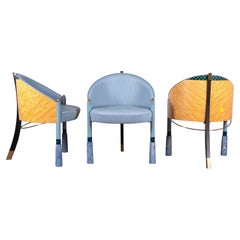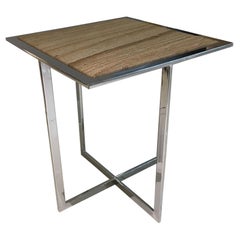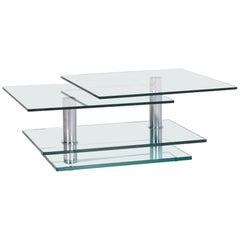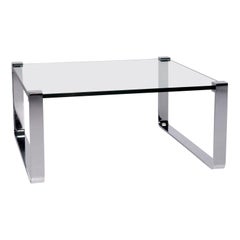Peter Draenert On Sale
Limited 100 Museum Edition "Sternensessel" Stars F3 Armchairs, Draenert
By Peter Draenert
Located in Grand Cayman, KY
Museum Edition Postmodern armchairs by Draenert.
Production limited to 100 pieces, many of which are in museums, including:
1. Metropolitan Museum of Art, New York
2. National ...
Category
Vintage 1980s German Post-Modern Chairs
Materials
Marble, Gold, Brass
$5,440 Sale Price / item
20% Off
H 32.38 in W 24.5 in D 21.25 in
Square Side Table With Polished Chrome Frame & Sandstone Top by Draenert
By Peter Draenert
Located in Chicago, IL
For 50 Years Draenert has been a top-brand of the International Furniture design.
In the tradition of a modern manufactory, we design and produce high-quality and sophisticated fu...
Category
21st Century and Contemporary German Modern Side Tables
Materials
Sandstone, Chrome
$1,926 Sale Price
20% Off
H 19.5 in W 17 in D 17 in
Recent Sales
Draenert Imperial Glass Coffee Table Function Movable Table
By Peter Draenert
Located in Cologne, DE
We bring to you a Draenert Imperial glass coffee table function movable table.
Product measurements in centimeters:
Depth 70
Width 105
Height 39.
Category
21st Century and Contemporary German Modern Coffee and Cocktail Tables
Materials
Glass
Draenert Classic 1022 Glass Coffee Table Silver Table
By Peter Draenert
Located in Cologne, DE
We bring to you a Draenert Classic 1022 glass coffee table silver table.
Product measurements in centimeters:
Depth 90
Width 92
Height 40.
Category
21st Century and Contemporary German Modern Coffee and Cocktail Tables
Materials
Glass
Draenert Intermezzo 1132 Designer Glass Table Silver by Georg Appeltshauser
By Peter Draenert, Georg Appeltshauser
Located in Cologne, DE
We bring to you a Draenert Intermezzo 1132 designer glass table silver by Georg Appeltshauser.
Product measurements in centimeters:
Depth 70
Width 69
Height 36.
...
Category
21st Century and Contemporary European Modern Coffee and Cocktail Tables
Materials
Glass
H 14.18 in W 27.17 in D 27.56 in
Draenert Santana Designer Fabric Armchair Black Chair Office Chair
By Peter Draenert
Located in Cologne, DE
We bring to you a Draenert Santana designer fabric armchair black chair office chair.
Product measurements in centimeters:
Depth 63
Width 60
Height 99
Seat-height 49
Rest-h...
Category
21st Century and Contemporary European Modern Chairs
Materials
Fabric
Draenert Santana Designer Fabric Armchair Set Black Chair
By Peter Draenert
Located in Cologne, DE
We bring to you a Draenert Santana designer fabric armchair set black chair.
Product measurements in centimeters:
Depth 63
Width 60
Height 99
Seat-height 49
Seat-depth 46
...
Category
21st Century and Contemporary European Modern Chairs
Materials
Fabric
Draenert Santana Designer Fabric Armchair Black Chair
By Peter Draenert
Located in Cologne, DE
We bring to you a Draenert Santana designer fabric armchair black chair.
Product measurements in centimeters:
Depth 63
Width 60
Height 99
Seat-height 49
Rest-height
Seat-d...
Category
21st Century and Contemporary European Modern Chairs
Materials
Fabric
People Also Browsed
Mario Bellini "Camaleonda" Sofa for B&B Italia, 1970, Set of 3
By Mario Bellini, B&B Italia
Located in Lonigo, Veneto
Mario Bellini "Camaleonda" modular sofa for B&B Italia, ivory bouclé, Italy, 1970, three elements.
"Camaleonda" is an icon, rediscovered. It was one of the truly modular sofa desig...
Category
Vintage 1970s Italian Mid-Century Modern Sectional Sofas
Materials
Bouclé, Plastic
$15,200 / set
H 23.63 in W 35.44 in D 35.44 in
Solana Wall Sconces
By Blueprint Lighting
Located in Westport, CT
The "Solana" wall mount sconce or reading light is strongly influenced by Scandinavian, Danish, French, and Italian Mid-Century Modernism. The walnut back plate (available in natural...
Category
21st Century and Contemporary American Mid-Century Modern Wall Lights an...
Materials
Enamel, Brass
'Plissé White Edition' Pleated Textile Table Lamp by Folkform for Örsjö
By Örsjö Industri AB
Located in Glendale, CA
'Plissé White Edition' pleated textile table lamp by Folkform for Örsjö.
This unique table lamp was awarded “Lighting of the Year 2022” by Residence Magazine Sweden, who called it “...
Category
21st Century and Contemporary Swedish Mid-Century Modern Table Lamps
Materials
Textile
$1,320 Sale Price / item
20% Off
H 16.1 in Dm 11.5 in
Mario Bellini "Camaleonda" Sofa for B&B Italia, Wool Bouclé, 1970, Set of 3
By B&B Italia, Mario Bellini
Located in Lonigo, Veneto
Mario Bellini "Camaleonda" modular sofa for B&B Italia, ivory wool bouclé, Italy, 1970, three elements.
"Camaleonda" is an icon, rediscovered. It was one of the truly modular sofa ...
Category
Vintage 1970s Italian Mid-Century Modern Sectional Sofas
Materials
Bouclé, Plastic
$16,200 / set
H 23.63 in W 35.44 in D 35.44 in
Sofa Model "Euroform", Maija Ruoslahti, Sopenkorpi, 1960s
Located in Helsinki, Uusimaa
Armchair Model "Euroform", designed by Maija Ruoslahti, manufactured by Sopenkorpi, Finland, 1960s. Gorgeous rosewood frame with brass details, reupholstered with quality model "Jagg...
Category
Vintage 1960s Finnish Scandinavian Modern Sofas
Materials
Brass
Mario Bellini "Camaleonda" Sofa for B&B Italia, Black Leather 1970, Set of 2
By B&B Italia, Mario Bellini
Located in Lonigo, Veneto
Mario Bellini "Camaleonda" modular sofa for B&B Italia, black leather, Italy, 1970, two elements.
"Camaleonda" is an icon, rediscovered. First designed in 1970 by Mario Bellini, it...
Category
Vintage 1970s Italian Mid-Century Modern Sectional Sofas
Materials
Leather, Plastic
$11,000 / set
H 23.63 in W 35.44 in D 35.44 in
1970 Bentwood Swivel Chair Model 'Convair' In Green Velvet by Oddmund Vad
By VAD Trevarefabrikk, Oddmund Vad
Located in Silvolde, Gelderland
Beautiful Scandinavian Modern bentwood ' model Convair' swivel lounge chair by Oddmund Vad for VAD Trevarefabrik in Norway. Featuring a floating circular bentwood frame and floor sta...
Category
Vintage 1970s Norwegian Scandinavian Modern Swivel Chairs
Materials
Velvet, Bentwood
$2,776
H 25.2 in W 31.5 in D 27.56 in
Frank Gehry Easy Edges Chairs and Ottoman
By Frank Gehry
Located in Los Angeles, CA
Frank Gehry pair of easy Edges chair and ottoman. Easy Edges, Inc. Canada/USA, 1972. Laminated cardboard, masonite. Chair: 29¼ H × 23¼ W × 39 D in, ottoman: 14¾ H × 17¾ W × 30 D in (...
Category
Mid-20th Century American Mid-Century Modern Chairs
Materials
Masonite, Paper
Set of 7 Camaleonda Sittings Designed by Mario Bellini for C&B Italia, 1970
By C&B Italia, Mario Bellini
Located in Varese, Lombardia
Set of modular armchairs and poufs in brown corduroy, mod. Camaleonda designed by Mario Bellini for C&B Italia in 1970.
The set consists of 7 elements:
- 4 armchairs ( cm 71 H x ...
Category
Vintage 1970s Italian Space Age Living Room Sets
Materials
Metal
$28,705 / set
H 27.96 in W 36.62 in D 37.8 in
Waterfall Contemporary Glossy White Lacquer Coffee Table by Driade
By Driade
Located in Chicago, IL
Even a coffee table can become a piece of art if it can stand regardless of the typological limitations. Fredrikson Stallard address the issue with the strength of the material to be...
Category
21st Century and Contemporary Italian Modern Coffee and Cocktail Tables
Materials
Lacquer
19th Century Georgian Marble Fireplace Mantlepiece
Located in London, GB
19th Century Georgian Marble Fireplace Mantlepiece.
An Extreemly Fine Hand Carved Fireplace Surround, Made From Italian Statuary White Marble.
With Hand Carved Panels Detailing To E...
Category
Antique 19th Century English Georgian Fireplaces and Mantels
Materials
Marble, Statuary Marble
$3,192 Sale Price
60% Off
H 45 in W 62.13 in D 7.63 in
Afra and Tobia Scarpa Brown Leather Two-Seater Soriana Sofa for Cassina, 1969
By Cassina, Afra & Tobia Scarpa
Located in Vicenza, IT
Soriana two-seater sofa, designed by Afra and Tobia Scarpa, and produced by the Italian manufacturer Cassina in 1969.
It features its original brown leather upholstery.
Winner of t...
Category
Vintage 1960s Italian Space Age Sofas
Materials
Chrome
$12,298 Sale Price
25% Off
H 26.38 in W 66.93 in D 39.38 in
Anemone Contemporary Soft Chair in Alpaca Fur and Wood Veneer by Brandi Howe
By Brandi Howe
Located in New York, NY
Anemone Shag Chair by Brandi Howe
W 66" x H 42.5" x D 32"
Alpaca Fur, Wood
Inspired by the stichodactyla gigantea anemone, this chair uses organic shapes and folds to fit the body...
Category
2010s American Modern Chairs
Materials
Fur, Alpaca, Wood
$50,000
H 42.5 in W 66 in D 32 in
Afra and Tobia Scarpa "Soriana" Sofa, Italy, 1969
By Afra & Tobia Scarpa
Located in Utrecht, NL
“Soriana” three seat bouclé sofa by Afra and Tobia Scarpa from Italy, 1969. The Post-Modern sofa was manufactured by Cassina and features three front metal clamps. The Soriana collec...
Category
Mid-20th Century Italian Mid-Century Modern Sofas
Materials
Metal
Arches Dining Chair, Walnut & Brass, InsidherLand by Joana Santos Barbosa
By InsidherLand, Joana Santos Barbosa
Located in Maia, Porto
Best Chair Design at the International Design & Architecture Awards 2021
Honorable Mention at the European Product Design Awards 2021
The Arches dining chair is designed in the like...
Category
21st Century and Contemporary Portuguese Modern Dining Room Chairs
Materials
Brass, Metal
$2,313 / item
H 35.04 in W 23.23 in D 26.38 in
Afra & Tobia Scarpa “Soriana” Three-seater Sofa for Cassina, Black Leather, 1969
By Afra & Tobia Scarpa, Cassina
Located in Lonigo, Veneto
Afra & Tobia Scarpa "Soriana" sofa for Cassina, Black Leather, 1969.
Although technically designed in the 1960s, the "Soriana" model by the Italian duo Tobia and Afra Scarpa is firm...
Category
Vintage 1960s Italian Mid-Century Modern Living Room Sets
Materials
Leather
$18,000
H 25.6 in W 98.43 in D 35.44 in
Get Updated with New Arrivals
Save "Peter Draenert On Sale", and we’ll notify you when there are new listings in this category.
More Ways To Browse
Chameleon Ware
Chantilly Vase
Chapman Manufacturing Spanish
Chapo Shelf
Charles Ahrenfeldt Porcelain
Charles Ahrenfeldt
Charles Cohen
Charles Eames Leg Splint
Charles Edward Stuart
Charles Reis
Charles Van Der Stappen
Charleston Battery Bench
Charleston Bed
Charoite Box
Chartreuse Crystal
Chase Shaker
Checker Vessel
Chelsea Botanical



